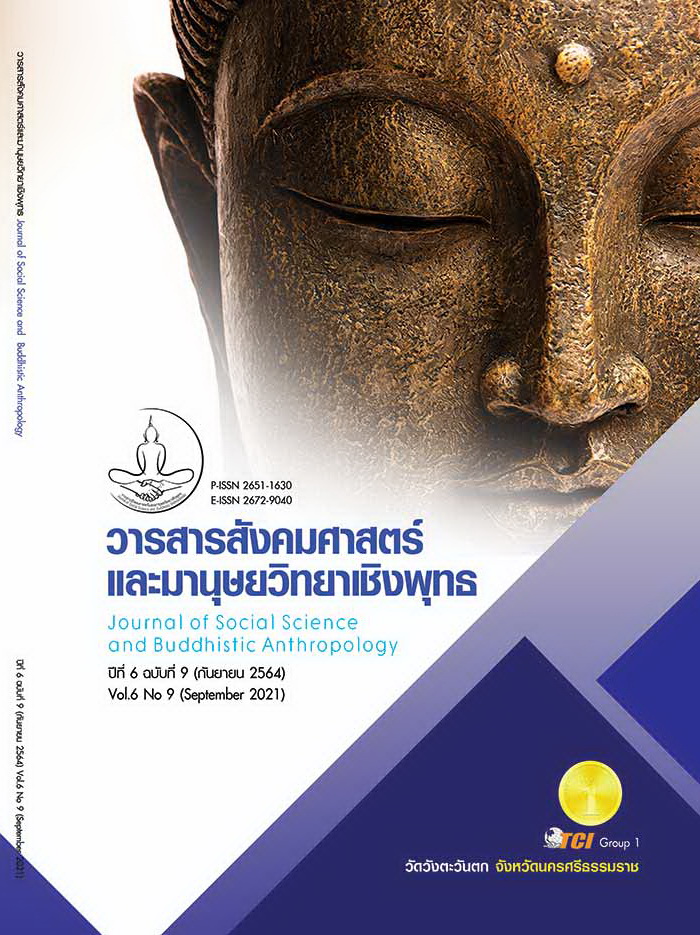PERSONAL FACTORS RELATED TO ADAPTIVE BEHAVIORS AMONG PREGNANT WOMEN WITH COMPLICATIONS
Keywords:
Complications During Pregnancy, Adaptation Behaviors, Personal FactorsAbstract
The objectives of this article were to identify the personal factors; age, educations, marriage status, family income, the primary caregiver and the adaptive behaviors among pregnant women with complications and the personal factors related to adaptive behaviors among pregnant women with complications. The sample was composed of 100 pregnant women who had complications. Data were collected during July 2020 to October 2020. A system random sampling was used to recruit the sample. Data was collected by using questionnaires comprising the personal data, the adaptive behaviors among pregnant women with complications. The data was analyzed by descriptive statistics and Pearson’s product moment correlation coefficient and Chi-square test. The result found that the personal factors; the maternal age ranged from 20 - 35 (56%). More than of the participants (38%) had Finished primary school. Almost all of the participants (60%) lived with their husbands. Sixty percent had family incomes between 5,001 - 10,000 baht. More than half of the participants (58%) the primary caregiver were husbands. The adaptive behaviors among pregnant women with complications indicated a high adaptation level of pregnant women in the overview ( = 3.86, S.D. = 0.55). A focus on each mode aspect revealed a high level of adaptive behaviors among pregnant women with complications (physiological, role function, interdependence modes) (
= 3.87, S.D. = 0.64,
= 4.17, S.D. = 0.67,
= 4.22, S.D. = 0.51). Unless the overview aspect of adaptation in the self – concept mode was at a moderate level (
= 3.19, S.D. = 0.52). The personal factors; education, marriage status, primary caregiver were significantly correlation with adaptive of behaviors among pregnant women with complications (χ2 = 15.124, 15.405, 12.437, p < .01, respectively), age, income of the family relationship were significantly positive correlation with adaptation of behaviors among pregnant women with complications (r = .491, .265, p < .01 respectively).
References
กระทรวงสาธารณสุข. (2562). สถิติสาธารณสุข กระทรวงสาธารณสุข. เรียกใช้เมื่อ 5 กรกฎาคม 2563 จาก http://healthkpi.moph.go.th/kpi2/kpi/index/?id=1409
กิ่งดาว แสงจินดา. (2559). ปัจจัยที่มีความสัมพันธ์กับพัฒนกิจการเป็นมารดาของหญิงตั้งครรภ์วัยรุ่นที่ ตั้งครรภ์โดยไม่ตั้งใจ. ใน วิทยานิพนธ์คณะพยาบาลศาสตร์ สาขาวิชาผดุงครรภ์ชั้นสูง. มหาวิทยาลัย บูรพา.
กุสุมา หมวกมณี และมาลี ลิ่มสกุล. (2563). การปรับตัวของแม่วัยรุ่นต่อบทบาทความเป็นแม่ศึกษาเฉพาะกรณีคลินิกรักษ์ดรุณ โรงพยาบาลสุราษฏร์ธานี. วารสารสังคมสงเคราะห์ศาสตร์, 28(2), 60-85.
คณะกรรมการอำนวยการจัดทำแผนพัฒนาสุขภาพแห่งชาติ ฉบับที่ 12 กระทรวงสาธารณสุข. (2559). แผนพัฒนาสุขภาพแห่งชาติ ฉบับที่ 12 (พ.ศ. 2560-2564). เรียกใช้เมื่อ 20 ธันวาคม 2562 จาก http://wops.moph.go.th/ops/oic/data/2018091 4162453_1_pdf
คนึงสุข ภู่พิสุทธิ์. (2556). ปัจจัยที่มีผลต่อภาวะสุขภาพสตรีตั้งครรภ์. กรุงเทพมหานคร: ธนาเพรส.
จิตตระการ ศุกร์ดีและศิวิไลซ์ วนรัตน์วิจิตร. (2559). ปัจจัยที่ส่งผลต่อภาวะโลหิตจางจากการขาดธาตุเหล็กของ สตรีตั้งครรภ์ที่รับบริการฝากครรภ์ในโรงพยาบาลส่งเสริมสุขภาพตำบล. วารสารวิจัยทางวิทยาศาสตร์ สุขภาพ, 10(1), 1-7.
นันทพร แสนศิริพันธ์ และฉวี เบาทรวง. (2561). การพยาบาลและการผดุงครรภ์ : สตรีที่มีภาวะแทรกซ้อน. เชียงใหม่: บริษัท สมาร์ทโคตติ้ง แอนด์ เซอร์วิส จำกัด.
บุนนาค พวงทอง. (2558). ปัจจัยส่วนบุคคลที่สัมพันธ์กับพฤติกรรมการปรับตัวของหญิงตั้งครรภ์ที่มีภาวะโลหิตจางจากการขาดธาตุเหล็กในจังหวัดสุโขทัย. ใน วิทยานิพนธ์คณะพยาบาลศาสตร์ สาขาวิชาเวชปฏิบัติชุมชน. มหาวิทยาลัยนเรศวร.
บุนนาค พวงทอง และคณะ. (2560). ปัจจัยส่วนบุคคลที่สัมพันธ์กับพฤติกรรมการปรับตัวของหญิงตั้งครรภ์ที่มีภาวะโลหิตจางจากการขาดธาตุเหล็กในจังหวัดสุโขทัย. วารสารพยาบาลและสุขภาพ, 11(1), 16-27.
ประคอง กรรณสูต. (2554). สถิติศาสตร์ประยุกต์. กรุงเทพมหานคร: ไทยวัฒนาพานิช.
ปัญญา สนั่นพานิชกุล และยศพล เหลืองโสมนภา. (2558). การตั้งครรภ์ในหญิงวัยรุ่น: ปัจจัยทางด้านมารดาที่มีผลต่อทารก. วารสารศูนย์การศึกษาแพทย์ศาสตร์คลินิก โรงพยาบาลพระปกเกล้า, 32(2), 156-174.
พิมพ์ศิริ พรหมใจษา. (2557). ผลของการส่งเสริมการสนับสนุนทางสังคมต่อบทบาทการเป็นมารดาในสตรีตั้งครรภ์วัยรุ่น. พยาบาลสาร, 41(2), 97-106.
มาลีวัล เลิศสาครศิริ. (2560). แนวคิดและการพยาบาลสตรีตั้งครรภ์ที่มีภาวะแทรกซ้อน. (ปรับปรุงใหม่). กรุงเทพมหานคคร: โรงพิมพ์อัสสัมชัน.
รัตนาภรณ์ ตามเที่ยงตรง. (2560). ปัจจัยทำนายพฤติกรรมการส่งเสริมสุขภาพด้านโภชนาการของหญิงตั้งครรภ์วัยรุ่น. วารสารคณะพยาบาลศาสตร์ มหาวิทยาลัยบูรพา, 25(1). 49-60.
โรงพยาบาลสวรรค์ประชารักษ์. (2563). สถิติแผนกฝากครรภ์ โรงพยาบาลสวรรค์ประชารักษ์ จังหวัดนครสวรรค์. นครสวรรค์: โรงพยาบาลสวรรค์ประชารักษ์.
วิชชุลดา พุทธิศาวงศ์ และคณะ. (2560). ผลของโปรแกรมส่งเสริมการรับรู้ความสามารถของตนเองร่วมกับการสนับสนุนจากสามีต่อพฤติกรรมการบริโภคอาหารของหญิงตั้งครรภ์วัยรุ่น. วารสารมหาวิทยาลัยนราธิวาสราชนครินทร์, 9(3),12-24.
Lowdermilk, D. L. et al. (2016). Maternity & Women,s Health Care. (11th edition). New York: Elsevier.
Perry, S. E. et al. (2014). Maternal Child Nursing Care. (5th ed.). Canada: Elsevier.
Pillitteri, A. (2014). Maternal & child health nursing: care of the childbearing & childbearing Family. (7th ed). New York: Lippincott Williams & Wilkins.
Roy, C. et al. (2009). The Roy Adaptation Model and Research: Global Perspective. Nursing Science Quarterly, 22(3):209-211.
Thorndike, R. M. (1978). Correlational procedures for research. New York: Gardner.








